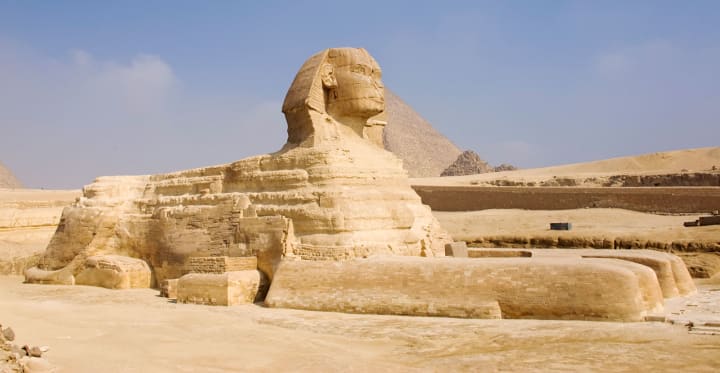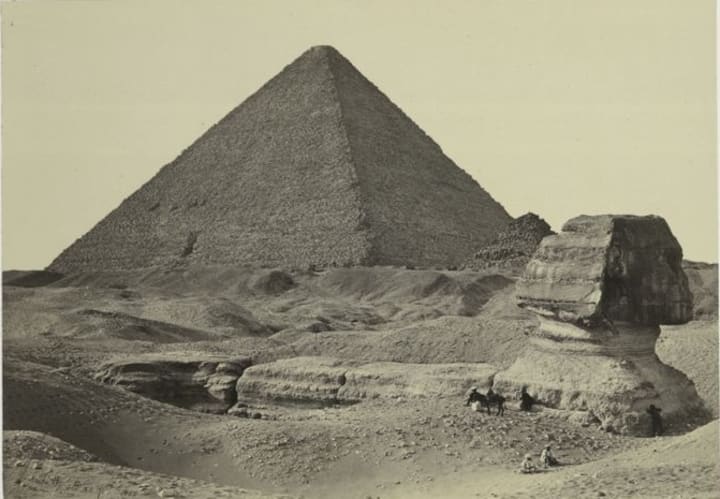Curiosity Rover Snaps Ancient Pyramids and Sphinx on Mars? (NASA PHOTO)
Did the NASA Curiosity Rover find Pyramids and a Sphinx on Mars?

Has NASA found Pyramids and a Sphinx on Mars?
On April 15, 2021, the NASA Curiosity rover captured 132 images atop "Mont Mercou" in Gale Crater. The imagery was then stitched together to create a 360-degree panorama of the Martian horizon.
As usual, the highly sophisticated camera returned stunning images of a stark landscape which bears an uncanny resemblance to many desert regions back here on Earth.
But, the similarities don't end there.
In this latest NASA public installment documenting the rover's photographic journey across the face of the Red Planet, it appears that an ancient mystery from our own world's distant past may have a parallel on Mars.
Is it possible that Curiosity captured the image of an ancient doppelganger mirroring the Great Pyramids and the Sphinx complexes still facing the ravages of time in modern-day Egypt?
The startling grouping of rocky mounds doesn't look much different from many other images captured by the venerable Mars rover in its nearly 10-year trek across the alien world. But, in this case, the particular formation of the triple pyramid shapes, dominated in the foreground by an eroded embankment resembling a Sphinx-like structure, stands apart from any other geographical feature discovered so far.
Present day images of the Giza complex, consisting of the three great pyramids dramatically framed behind the enigmatic Sphinx granite sculpture, show a highly excavated area revealing the glory of these ancient monuments, dating back thousands of years.

But, not too long ago, the site looked much different, due to being covered by layers of sand deposited over millennia.
In this photograph, taken in the 1880's (at the dawn of modern photography) it's clear to see the effects of weathering and erosion blanketing the area over the course of countless centuries.

Egyptologists and Archaeologists are at odds today over just how long ago the Sphinx was carved from the existing granite formation adorning the Giza plateau.
Prevailing historians have doggedly stuck to a narrative pinpointing the creation of the Sphinx and the building of the Pyramids to roughly the same time frame, estimated to be between four and five thousand years ago.
But, an ever growing number of scientists, geologists and citizen journalists are disputing that long held position. An enticing theory is emerging postulating that the structures are even more ancient in the extreme.
Some proponents of the new hypothesis claim there is evidence the Sphinx can be dated back more than 10,000 years and that the pyramids were built thousands of years earlier than the widely accepted timeline being taught in academia today.
The basis of this startling new theory rests on evidence of water erosion rings scarring the Sphinx, dating its origins back to a time when the Giza plateau was not desert, but rather a fertile plain hugging the shores of the Nile river.
Even skeptics admit that geological evidence confirms such conditions existed long before the Fourth Dynasty, the purported era (2613 to 2494 BC) when the Pyramids were supposedly built and the Sphinx carved from stone.
Mysteries surrounding the age and method of construction of these ancient monuments have persisted as far back as recorded history. But why they were made and, perhaps more importantly, how that was accomplished, have vexed the greatest minds of every age since.
A new crop of Egyptologists are increasingly more open to the premise that the pyramids and the Sphinx were constructed by an even more ancient civilization with technology equal to, or even greater than, our own.
Is it possible such a civilization may have engaged in a similar construction project on Mars in the deep past? Could weathering have produced a similar result considering the millions of years elapsed since Mars was more inhabitable?
Photographs can only tell us so much. It's not until scientists land on Mars and investigate this mystery that a truly definitive answer to those questions can be arrived at.
Until then, there's only the video to stir the imagination.
About the Creator
Reid Moore
I am a Freelance Writer living in Riverside California who writes on a wide variety of topics including News, Politics, Popular Culture, Science, Music, Fiction, Poetry and Art.
Read More by Reid Moore!






Comments
There are no comments for this story
Be the first to respond and start the conversation.